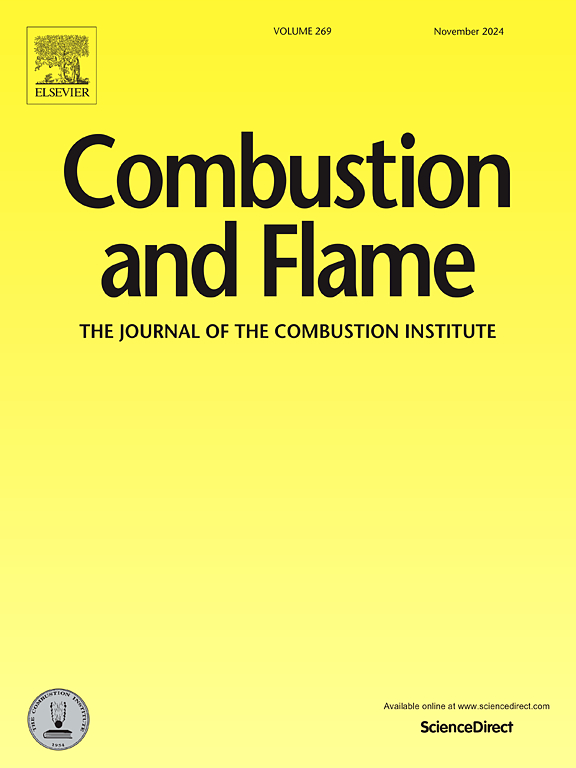Examination of differential diffusion effects in spatially-developing supersonic mixing layer hydrogen flames
IF 5.8
2区 工程技术
Q2 ENERGY & FUELS
引用次数: 0
Abstract
Differential diffusion (DD) plays a crucial role in the fundamental understanding of combustion process, particular in the context of hydrogen or hydrogen-blended fuel flames. This paper intends to address whether the impact of DD on the flame stabilization in the turbulence-dominant supersonic flow can be negligible and if not, to elucidate its mechanisms. To this end, a spatially-developing supersonic non-premixed mixing layer hydrogen flame is simulated by large eddy simulations. Three distinct flow-chemistry interaction patterns: laminar flow-chemistry, transition-chemistry, and turbulence-chemistry are well designed within the mixing layer to examine the dependence of the DD effect on turbulence and its implications for flame stabilization. Results show that the importance of DD in flame-base zones of transition-chemistry and turbulence-chemistry interaction patterns is more pronounced than in laminar flow-chemistry one, even though their turbulence effects are more significant. The DD effect is observed to shorten the flame lift-off length and shift the leading point dynamic from a low-frequency to a high-frequency mode. Further “budget analysis” of transport- and chemistry- effect of DD shows that although the transport contribution of DD diminishes in turbulence-dominant flow-chemistry interaction patterns, the chemistry contribution of DD, i.e., sensitivity of the ignition delay time (IDT) to DD, is increased due to the low mixture temperature. Specifically, even a minor increase in the concentration of certain radicals, such as H, caused by DD can result in a significant reduction in IDT. This is primarily responsible for DD shortening the flame lift-off length within transition-chemistry and turbulence-chemistry interaction patterns. In laminar flow-chemistry pattern, DD facilitates the reaction to withstand high strain rates and in turn reducing the flame lift-off length.
研究空间发展超音速混合层氢焰中的差分扩散效应
微分扩散(DD)在燃烧过程的基本理解中起着至关重要的作用,特别是在氢或氢混合燃料火焰的背景下。本文旨在探讨在紊流占主导地位的超声速流动中,DD对火焰稳定的影响是否可以忽略不计,如果不能,则阐明其机理。为此,采用大涡模拟的方法对空间发展的超音速非预混层氢火焰进行了模拟。在混合层内设计了三种不同的流动化学相互作用模式:层流化学、过渡化学和湍流化学,以研究DD效应对湍流的依赖性及其对火焰稳定的影响。结果表明,在过渡-化学和湍流-化学相互作用模式的火焰基区,DD的重要性比层流-化学相互作用模式更为显著,尽管它们的湍流效应更为显著。DD效应使火焰升离长度缩短,并使先导点动态从低频模式转变为高频模式。进一步对DD输运效应和化学效应的“预算分析”表明,虽然在湍流主导的流动-化学相互作用模式中DD的输运贡献减小,但由于混合温度较低,DD的化学贡献,即点火延迟时间(IDT)对DD的敏感性增加。具体来说,即使是由DD引起的某些自由基(如H)浓度的轻微增加,也会导致IDT的显著降低。这是DD在过渡-化学和湍流-化学相互作用模式中缩短火焰起飞长度的主要原因。在层流-化学模式中,DD有助于反应承受高应变速率,从而减少火焰的上升长度。
本文章由计算机程序翻译,如有差异,请以英文原文为准。
求助全文
约1分钟内获得全文
求助全文
来源期刊

Combustion and Flame
工程技术-工程:化工
CiteScore
9.50
自引率
20.50%
发文量
631
审稿时长
3.8 months
期刊介绍:
The mission of the journal is to publish high quality work from experimental, theoretical, and computational investigations on the fundamentals of combustion phenomena and closely allied matters. While submissions in all pertinent areas are welcomed, past and recent focus of the journal has been on:
Development and validation of reaction kinetics, reduction of reaction mechanisms and modeling of combustion systems, including:
Conventional, alternative and surrogate fuels;
Pollutants;
Particulate and aerosol formation and abatement;
Heterogeneous processes.
Experimental, theoretical, and computational studies of laminar and turbulent combustion phenomena, including:
Premixed and non-premixed flames;
Ignition and extinction phenomena;
Flame propagation;
Flame structure;
Instabilities and swirl;
Flame spread;
Multi-phase reactants.
Advances in diagnostic and computational methods in combustion, including:
Measurement and simulation of scalar and vector properties;
Novel techniques;
State-of-the art applications.
Fundamental investigations of combustion technologies and systems, including:
Internal combustion engines;
Gas turbines;
Small- and large-scale stationary combustion and power generation;
Catalytic combustion;
Combustion synthesis;
Combustion under extreme conditions;
New concepts.
 求助内容:
求助内容: 应助结果提醒方式:
应助结果提醒方式:


